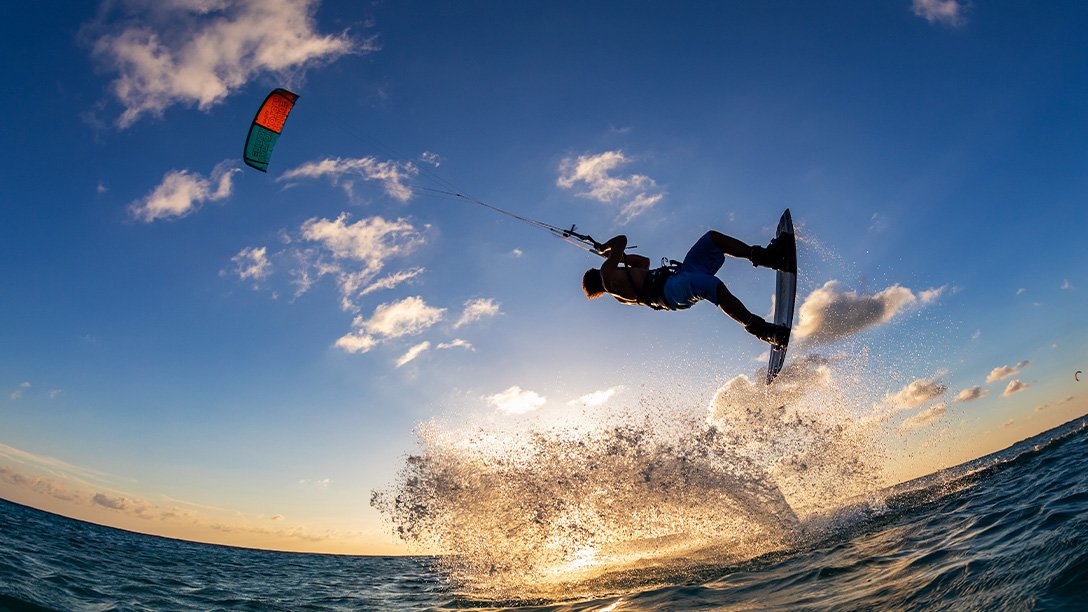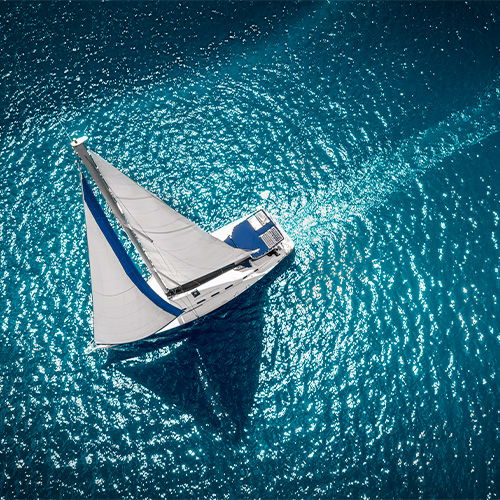Venturing into the world of kitesurfing without proper guidance can be both difficult and risky. That's why enrolling in a well-regarded maritime school is a wise move. You'll gain invaluable insights and techniques from seasoned kite surfers and have the confidence of learning practical skills under expert supervision.
In this article, we've assembled a thorough beginner's guide to help you get started in this exhilarating sport. From decoding basic kitesurfing terms to offering practical how-to advice, we've got you covered. We also spotlight some of the top kitesurfing destinations across the USA and recommend reputable schools where you can hone your skills.
Understanding Kitesurfing: What Is It Really?
Although kitesurfing has been a mainstream pastime since the 1970s, the concept of employing kites for propulsion can be traced back to the 12th century. At that time, communities in Polynesia, Indonesia, and China utilized kites in their fishing boats for navigation. Fast forward to the 19th century, British inventor George Pocock patented a kite-driven traction system to power cars and boats. Throughout the years, numerous inventors and athletes tinkered with kite-based traction systems, adding their own unique contributions. The sport as we know it today began to take shape in 1977 when Gijsbertus Adrianus coupled a kite with a surfboard. He patented his invention and is now widely regarded as the pioneer of modern kitesurfing.
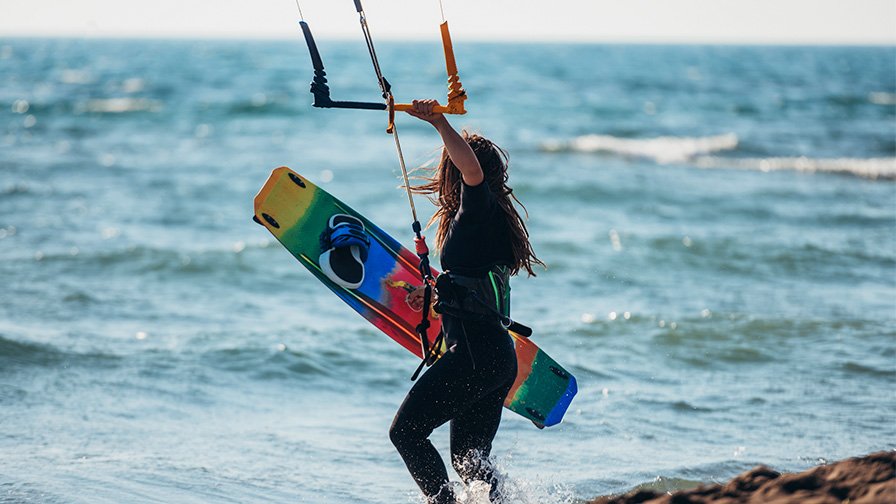
Understanding Kitesurfing
capetanos.comUnderstanding the terminology of kitesurfing can greatly enhance your experience on the water, helping you interact effectively with fellow kiteboarders and accelerate your learning curve. Here are some essential terms to get you started:
- Knot: In the context of kitesurfing, a 'knot' refers to a unit of wind speed, equivalent to one nautical mile per hour or 1.15 regular miles per hour/1.85 kilometers per hour.
- Offshore Wind: This term signifies that the wind is blowing from the land towards the water. It's highly recommended to avoid riding in offshore winds, as you could find yourself drifting too far from shore.
- Upwind/Downwind: Riding 'upwind' means you're going against the wind's direction, while 'downwind' refers to riding in the direction the wind is blowing.
- Chicken Loop: This is the loop used to connect the rider to the hook on the bar control system, a crucial component for maintaining control while riding.
- Quick Release: This safety feature allows the rider to quickly disconnect from the kite or the leash, particularly useful in situations like strong offshore winds.
For an in-depth look at kiteboarding terminology, check out this comprehensive article: https://www.surfertoday.com/kiteboarding/the-glossary-of-kiteboarding-terms
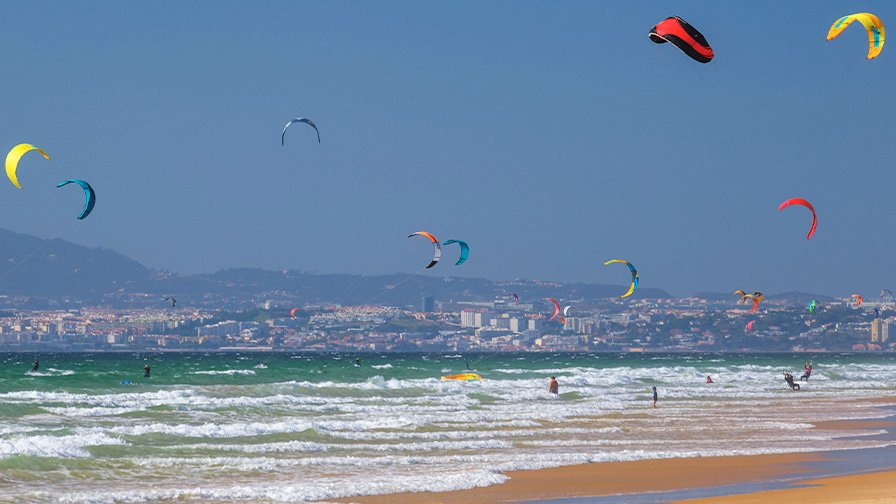
Thrills of Kitesurfing
capetanos.comWhy Opt for the Thrills of Kitesurfing?
Each year, countless individuals across the globe feel the urge to pick up a new hobby. Whether the motivation is to stay fit, devote more time to personal interests, or meet like-minded people, kitesurfing is a hobby that offers something for everyone. Here are some compelling reasons to give kitesurfing a try:
- Join a Global Community: Enrolling in a kitesurfing school provides you with the unique opportunity to connect with people who share your interests, whether that be hanging out at the beach, honing their kite skills, or traveling to the world's best kiting spots.
- Elevate Your Self-Esteem: It's widely acknowledged that acquiring new skills is an excellent way to boost self-confidence. In the realm of kitesurfing, the learning curve is continuous-there are always new maneuvers to master and techniques to refine, each contributing to your sense of accomplishment.
- Enhance Balance and Coordination: Similar to other board sports, maintaining balance and proper body positioning are crucial for excelling in kitesurfing. You'll find yourself dedicating time and effort to perfect these aspects. Additionally, controlling the kite will improve your hand-eye coordination and demand focused concentration, especially in the early stages.
- Benefit Your Physical and Mental Health: Scientific studies have shown that outdoor activities contribute positively to both mental and physical well-being. Once you become a proficient kitesurfer, the sport offers a range of intensity levels-from meditative glides to adrenaline-pumping stunts-all contributing to your overall health."
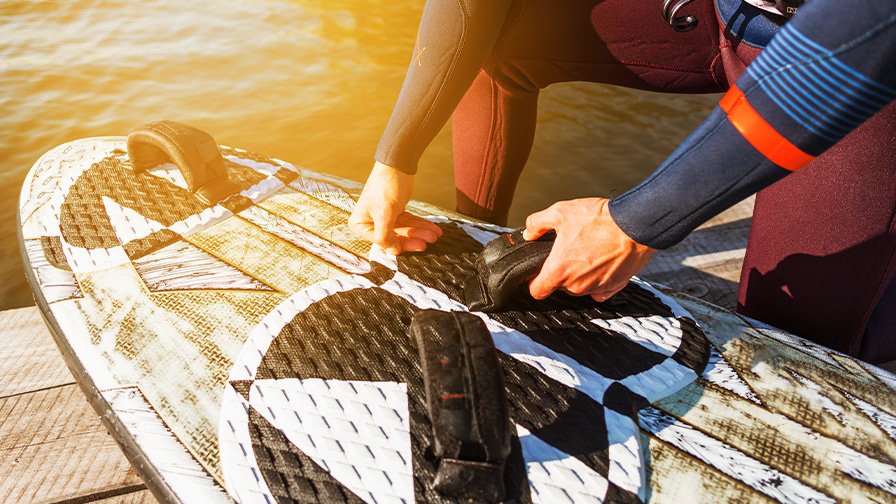
Essential gear for beginners’ kitesurfing
capetanos.comEssential gear for beginners’ kitesurfing
Embarking on your kitesurfing journey is exciting, but nothing enhances your initial experience like having the correct gear at your disposal. High-quality, reliable equipment not only simplifies the learning process but also significantly amplifies the joy of riding the waves. Below is an in-depth look at each piece of essential gear that every novice in the world of kitesurfing should consider:
The Kite: Your Wind-Powered Companion
A kite that's free of visible damage and well-maintained is absolutely crucial for a smooth ride. Make sure you educate yourself on how to spot leaks when setting up your kite for the first time. The variety of kites you can opt for includes:
- Bow Kite: Known for providing the rider with an expansive wind range and ease of relaunching, these are often a beginner's favorite.
- C Kite: These sit deep in the wind window and offer a much smaller wind range, which makes them stable but less versatile.
- Delta Kite: Ideal for beginners to intermediates, Delta kites provide a balance between stability and performance.
- Foil Kite: With no leading edge or struts to inflate, Foil kites utilize air-filled cells. They excel in upwind or downwind performance and are typically used in foil racing.
The Bar: Your Control Center
Make it a point to inspect the lines for any fraying or cuts. The bar is an essential piece that, when combined with the lines and the bridle system, connects you, the rider, to the kite. This setup helps in transferring the forces from the kite to create propulsion. While 4-line and 5-line systems are both suitable for beginners, starting with a 5-line setup can help in understanding how to utilize the fifth line for various skills such as relaunching.
Seat Harness: Optimal Support
A seat harness is generally recommended for beginners over a waist harness. Waist harnesses have a tendency to shift and move upwards, affecting your center of gravity and subsequently your balance. For those with back problems or those who need extra lumbar support, a seat harness is a superior choice.
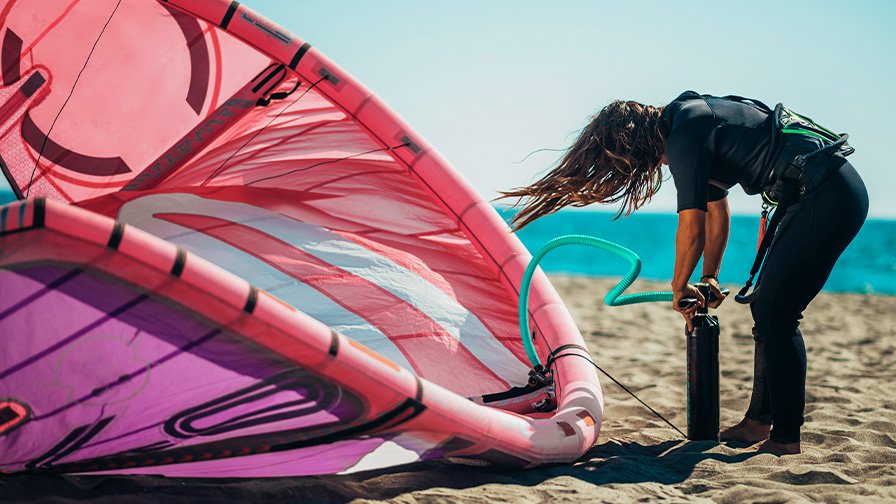
Safety Leash
capetanos.comSafety Leash: The Non-Negotiable
A safety leash is imperative for anyone venturing into kitesurfing. Never enter the water without one, as it is your last line of safety in unexpected wind conditions.
Protective Clothing: Safety First
The importance of helmets, water shoes, and wetsuits cannot be stressed enough. Helmets prevent potential head injuries, water shoes protect against underwater hazards like sharp objects, and wetsuits provide thermal protection in varying water temperatures.
By thoughtfully investing in these core pieces of kitesurfing gear, you set yourself up for not only an easier learning experience but also a safer and more enjoyable adventure on the waves. Here are some shops you can buy your gear from:
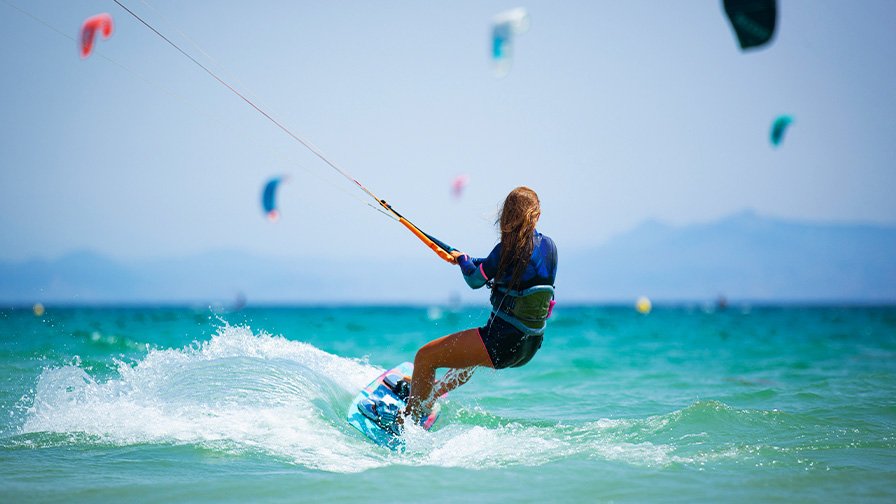
Protective Clothing
capetanos.comUnlocking Mastery in Kitesurfing: Skills and Mindsets for Success
While kitesurfing can feel somewhat challenging in its initial phase, rest assured that most people rapidly transition from being a complete novice to genuinely enjoying the sport. The key to this transformation lies in your equipment, location, and most crucially, the guidance of a certified kitesurfing instructor.
Arguably, the most valuable asset you can bring to your kitesurfing adventure is mental fortitude. As in life, you will encounter both highs and lows on your journey; perhaps you'll even have a few spills off the board. It's your ability to rise again, paired with a positive mindset, that will dictate your ultimate success in this sport. A lighthearted approach to the inevitable learning curve puts you several steps ahead.
Comfort and confidence in the water are indispensable skills for any kitesurfer. Whether it's getting off the shore, untangling lines, or handling accidental falls, your ease in the water can make or break your experience. Being adept at swimming and comfortable with treading water can go a long way in preventing unnecessary panic when faced with challenges.
Kite control is a nuanced skill that becomes pivotal as you grow in the sport. Your instructor might initiate you with a land-based 'training kite' to acquaint you with the basics. Gaining a solid understanding of the wind window and power zone will be vital as you aim to advance your capabilities.
Seasoned kitesurfers develop a keen sense for 'reading' the elements—wind direction, sea currents, and other intricate factors that make up the sea's 'mood' can all impact your performance. As you gain experience, you'll learn to interpret these signs and adjust your strategy accordingly, ensuring that you're making the most of optimal conditions while sidestepping less favorable ones.
While confidence and basic physical fitness serve as your initial toolkit for kitesurfing, your journey in mastering this sport will bring forth a wealth of skills that enrich not just your time on the water but also your life in general. Here are some YouTube videos about tips for kitesurfing:
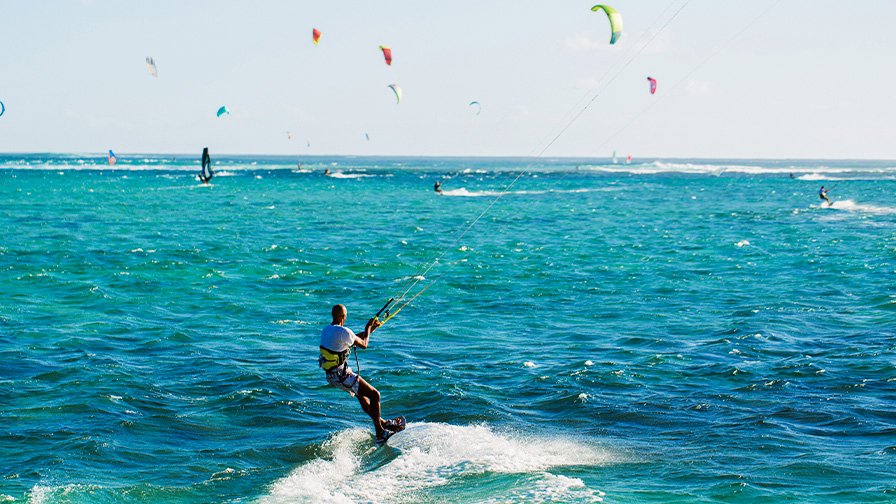
Mastery in Kitesurfing
capetanos.comTips for Beginners
- Avoid Pulling the Bar: As a beginner, remember that pulling the bar gives you more power-something you don't want when things go awry. In a panicked state, pulling the bar will only worsen your situation, causing a harder crash.
- Mind Your Hand Placement: The way you hold the bar matters. Keep your hands closer to the center to ensure better control. Hands at the edges make the kite sensitive and difficult to manage, especially when using one hand.
- Full Release During Launch and Land: Whenever you launch or land your kite, ensure your bar is fully released. This depowers the kite and eases tension in the steering lines, making it safer and easier to manage your kite's movement.
- Keep Your Chest Aligned with the Kite: During your ride, maintain a posture where your chest is always facing your kite. This helps balance your weight, allowing you to lean back into your harness to counteract the kite's pull effectively."
By following these essential tips, you'll be on the right path to becoming a skilled and safe kitesurfer.
Regardless of your current skill level, instructional videos are an excellent resource for rapid progress. YouTube offers a plethora of tutorials that break down various tricks, each providing unique insights that could be the key to your improvement. Watch these videos multiple times, paying close attention to varying elements like kite position, body mechanics, board movement, and timing.
Moreover, taking to the water with a kitesurfing companion can greatly enrich your experience. Embarking on new challenges together provides mutual encouragement, cutting down on procrastination and excuse-making. Plus, you'll likely find that your friend is encountering just as many setbacks as you are. After your session, treat yourselves to a meal and swap stories about your most memorable crashes. It's all part of the learning—and the fun!
Best Kite Surfing Locations in the USA
The United States offers a kaleidoscope of kiteboarding locations, each with its own unique appeal and conditions suitable for a range of skill levels. From the sun-kissed Gulf to the rugged Atlantic, and the expansive Pacific, the choices are abundant. Whether you're a beginner dipping your toes in the water or an advanced rider seeking new thrills, there's a perfect spot for you. Here's a closer look at some standout destinations.
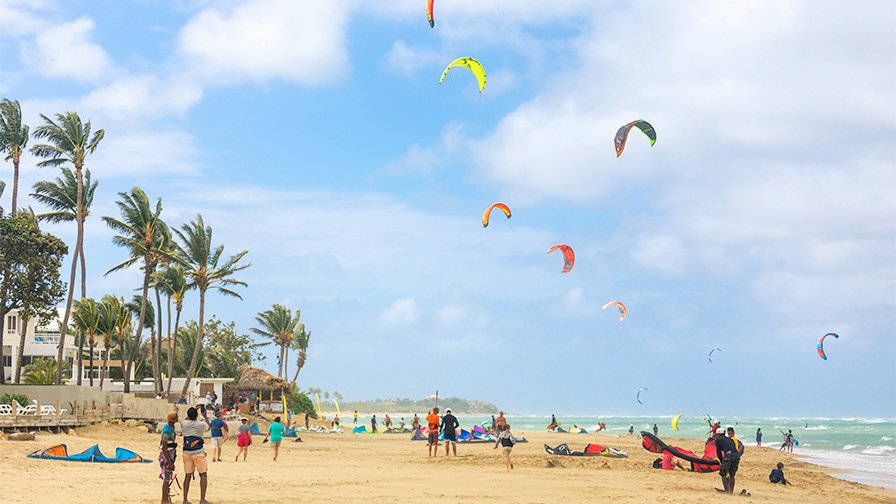
Best Kite Surfing Locations in the USA
capetanos.com- Oahu, Hawaii: Known as the spiritual birthplace of kiteboarding, Hawaii is a mecca for enthusiasts. Legends like Robby Naish and Pete Cabrinha have honed their skills on these waters. Kailua Bay, situated on Oahu's lush eastern side, offers world-renowned beaches with powdery white sand and inviting turquoise waters. However, it's worth noting that this popular spot can get crowded with both kiteboarders and beachgoers. To make the most of your time, opt for quick takeoffs and landings and venture further into the expansive bay to avoid the crowds. A pro tip: there's a large grassy area at the north end of the bay that's ideal for setting up your gear.
- Columbia River Gorge, Oregon: This location is an adventurer's paradise, offering the unique opportunity to mountain bike or hike in the morning and hit the water in the afternoon. Home to seasoned American kiteboarders like Colleen Carrol and Brandon Scheid during the summer months, Hood River also houses several kiteboarding brand headquarters. One fascinating feature here is the river current, which flows in the opposite direction to the wind, making it easier to stay upwind on lighter days.
- San Francisco, California: Melding a world-famous travel destination with exhilarating kiteboarding spots, San Francisco provides an unforgettable experience. For many, kiteboarding under the iconic Golden Gate Bridge is a bucket-list item. While the scenery is breathtaking, the area can be challenging and is best suited for those with advanced skills. Ocean Beach, within San Francisco proper, offers an extensive sandy stretch similar to renowned kitesurfing beaches in places like Cabarete. With significant swells, strong currents, and ample space for gear setup, it's a dream locale for experienced riders. However, consulting local kiteboarders about potential hazards is a wise precaution.
These highlights barely scratch the surface of what the U.S. has to offer. For a more comprehensive overview, check out the list of the top 10 kiteboarding spots in America. Your next wind-catching adventure awaits!
Nautical Schools: The Best Way to Learn
Kiteboarding is not just an adrenaline-packed sport; it's a symphony where the elements of wind, water, and sun harmonize to give you an unforgettable experience. And let's not forget, it's an excellent way to keep fit and build muscle. But why should you invest in formal kiteboarding lessons rather than relying on DIY videos or tips from friends? Here's why:
The Importance of Kiteboarding Lessons
- Safety First: Though exhilarating, kiteboarding comes with its share of risks. The danger of crashing into rocks, piers, or even fellow beach-goers is all too real. Structured lessons equip you with the skills to handle these situations effectively, minimizing the risk of injury. It's not a sport to dabble in without proper training and guidance.
- Rapid Learning Curve: Don't waste precious time wading through YouTube tutorials or skimming instructional books. Nothing beats hands-on, expert-led training to familiarize you with the equipment and natural conditions. Certified lessons offer an accelerated, yet comprehensive, learning experience.
Premier Kiteboarding Schools in the USA
- SoCal Kitesurfing, Long Beach: Ranked as the #1 IKO Center in the USA and the #3 IKO Pro Center globally, SoCal provides high-quality instruction from certified trainers. Students even earn their own kiteboarding certification. Offering tailored equipment for your learning curve, a 90-minute introductory lesson starts at $100.
- KGB Kiteboarding, San Francisco: Serving the Bay Area since 2013, KGB Kiteboarding provides top-notch coaching and gear. With a focus on quality instruction, their "Taster" lesson gives you a ground-level experience of the sport for $100.
So, as you contemplate riding the wind and waves, remember that the right education and equipment can make all the difference. Choose a renowned kiteboarding school and soar safely into your new adventure.
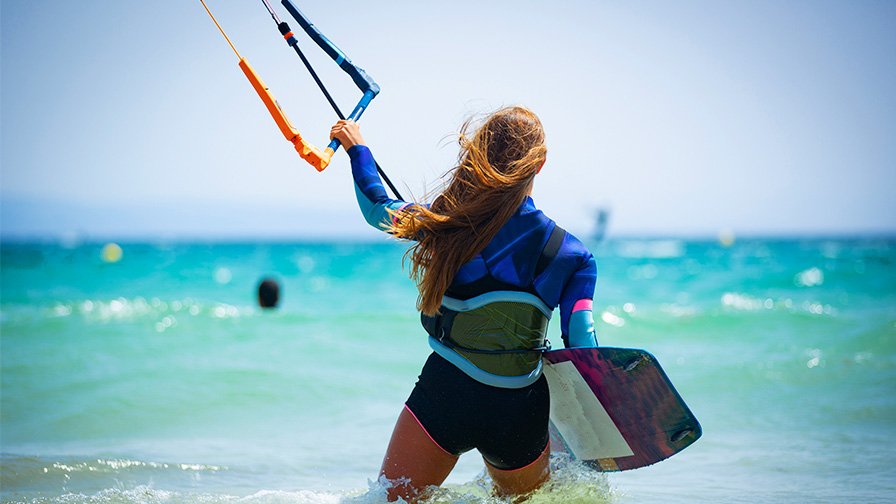
Kitesurfing is an experience
capetanos.comIn conclusion, kitesurfing is not just another sport; it's an experience that can change your life for the better. Imagine skimming across the water's surface, wind in your hair, sun on your face, and a sense of freedom like never before. But it's not just about the thrill; kitesurfing is also a comprehensive workout, engaging multiple muscle groups and improving your overall physical health.
However, as with any extreme sport, safety should be your utmost priority. It's crucial to undertake formal training, especially when you're just starting out. Proper instruction from certified professionals not only ensures that you learn the correct techniques, but it also dramatically reduces the risks associated with the sport. By learning from the experts, you'll progress faster, gaining the confidence to tackle more challenging conditions safely.
So, what are you waiting for? Take the plunge into the exhilarating world of kitesurfing. Don't settle for watching videos or reading about it—experience it for yourself! Locate a reputable nautical school near you and sign up for an introductory course. Even just one lesson can provide you with valuable insights into this amazing sport and ignite a passion you never knew you had. Dive in and let the winds of adventure guide you!
